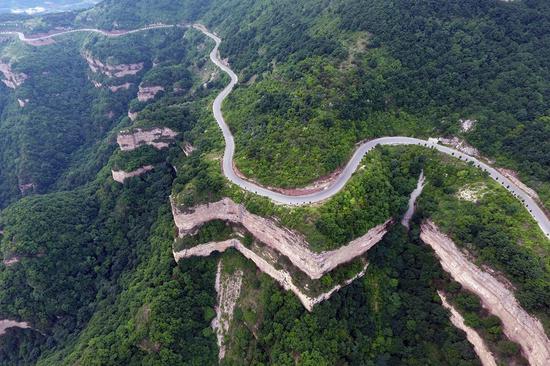Better roads lead to China's rural vitalization
2021-03-29 Xinhua Editor:Mo Hong'e
Aerial photo taken on June 18, 2019 shows a road in Wuxiang County of north China's Shanxi Province. (Xinhua/Zhan Yan)
The major road in Lingtou, a small village in north China's Shanxi Province, is named "Weishang," meaning small online shops. Many locals are engaged in e-commerce, including villager Zhang Xiaoying.
Zhang, 53, sells millet, beans, eggs, honey and other agricultural products both online and offline. With logistics services available at her doorstep, she brought home more than 100,000 yuan (15,290 U.S. dollars) in 2020.
In the same year, the cement road to her village was widened, allowing large trucks to enter. "My business wouldn't be as booming as it is without the road," Zhang said.
As China advances rural vitalization following its eradication of absolute poverty, improved rural roads have helped farmers dispatch their goods and brought tourists and other resources, facilitating the development of industries including e-commerce, tourism and agriculture with local characteristics.
The total length of China's rural roads will stabilize at approximately 5 million km by 2035, and the quality of roads leading to townships and villages will be further improved, Wang Zhiqing, vice minister of transport, told a press conference on Wednesday.
Currently, China's rural roads total 4.2 million km in length. The country is not simply pursuing an increase in its rural road mileage, but strives to promote the integration of transportation construction, resource development and industrial development in rural areas to better serve rural vitalization.
After a section of the "Great Wall No.1 Tour Road" was built in Shanxi in 2018, tourists swarmed into Zhenbianbu, a formerly impoverished village at the foot of the Great Wall in Yanggao County.
Former migrant worker Zhang Yuewen, 25, has returned home and opened a small workshop selling homemade grain liquor to tourists.
"Despite the epidemic, I earned more than 70,000 yuan last year, twice my income as a migrant worker," he said.
In 2020, the per capita net income of villagers more than tripled from the level in 2014 to over 7,000 yuan.
From 2016 to 2020, China's investment in its rural road network topped 310 billion yuan.
In Longxi County, northwest China's Gansu Province, a 7-km road connecting Liujiazhang Village to a nearby township was constructed in 2017, enabling villagers to sell their herbs with much lower transport costs.
Villager Li Yanjie said that before the new road was built, vehicles were reluctant to come as they were often stuck in the mud after it had rained. "Herbal plantation has become our pillar industry, partly because of the better road access."
According to the Outline of the 14th Five-Year Plan (2021-2025) for National Economic and Social Development and the Long-Range Objectives Through the Year 2035, China will put forward a "road chief" system, in which specific personnel will be responsible for building, managing, maintaining and operating rural roads.
The huge rural road network has strongly stimulated rural production and consumption and played a big supporting role in building a moderately prosperous society in all respects, said Yang Wude, vice president of Shanxi Agricultural University.
"Roads remain a priority for rural vitalization. More developed transportation will further stimulate the vitality of rural development and the market," said Yang.
Copyright©1999-2021 Chinanews.com All rights reserved.

